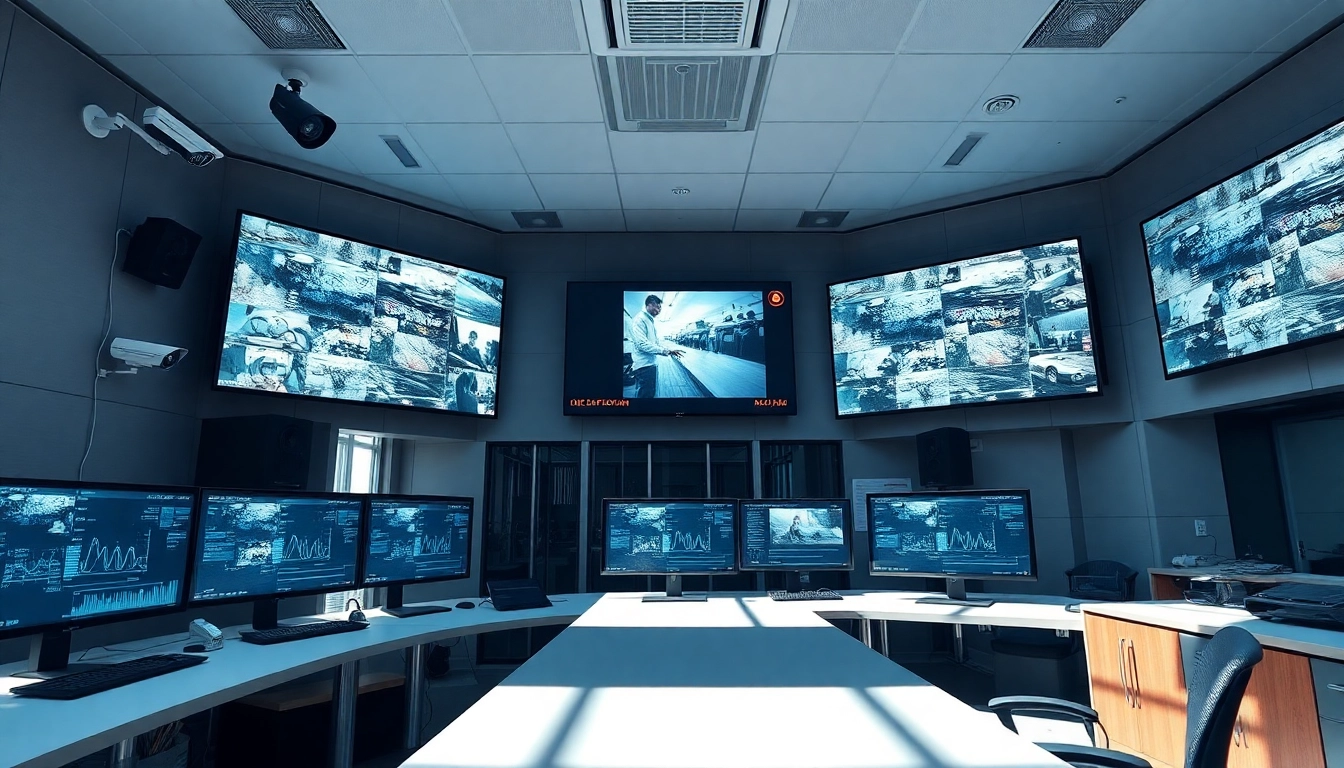Understanding CCTV & Remote Monitoring Systems
What is CCTV & Remote Monitoring?
CCTV (Closed Circuit Television) & Remote Monitoring is a security measure that employs video cameras to transmit signals to specific monitoring locations. This technology has evolved significantly, allowing business owners, property managers, and homeowners to monitor their premises from virtually anywhere, facilitating a proactive approach to security. By integrating advanced technology, systems are capable of recording, analyzing, and transmitting data to provide real-time insights about the state of security. In essence, CCTV & Remote Monitoring serves as an invaluable tool for safeguarding assets and ensuring peace of mind.
The Components of a CCTV System
A comprehensive CCTV system consists of several interconnected components, each playing a crucial role in achieving effective surveillance. Understanding these elements can empower users to make informed decisions about their security setups:
- Cameras: The cornerstone of any CCTV system, cameras are responsible for capturing video footage. They come in various types such as dome, bullet, and PTZ (pan-tilt-zoom), suitable for different environments and needs.
- DVR/NVR: A Digital Video Recorder (DVR) or Network Video Recorder (NVR) is essential for storing recorded footage. DVRs are typically used with analog cameras, while NVRs are used with IP cameras, offering superior video quality and ease of access.
- Monitors: These are used to display live or recorded video footage, allowing users to observe activities in real-time.
- Network Connection: For remote monitoring, a reliable internet connection is necessary, enabling users to access real-time feeds and recorded footage from anywhere in the world on their smartphones or computers.
- Power Supply: Ensuring that equipment remains operational is critical, requiring uninterruptible power supplies or battery backup solutions.
Benefits of CCTV & Remote Monitoring
The advantages of implementing CCTV & Remote Monitoring systems are substantial, contributing to a safer environment. Key benefits include:
- Deterrence: The mere presence of cameras can deter potential criminals, as they know their actions are being recorded.
- 24/7 Surveillance: Continuous monitoring provides an around-the-clock security presence, essential for detecting suspicious activities in real-time.
- Remote Access: Users can access live feeds and stored footage remotely, providing flexibility and peace of mind even while away from the premises.
- Incident Documentation: In the event of a crime, recorded footage can serve as vital evidence for investigations and insurance claims.
- Enhanced Safety: By monitoring properties consistently, managers and homeowners can respond to incidents swiftly, reducing response times and enhancing overall safety.
Choosing the Right CCTV & Remote Monitoring Solution
Factors to Consider When Selecting Systems
When choosing a CCTV & Remote Monitoring system, several critical factors should guide the decision-making process:
- Type of Surveillance: Determining the required type of surveillance—indoor, outdoor, or both—will influence the choice of cameras and installation methods.
- Resolution: Higher resolution cameras provide clearer images and details, which are essential for identifying individuals or incidents. Aim for at least 1080p resolution for effective monitoring.
- Storage Capacity: Consider how much footage you need to store and for how long. This will impact your choice of DVR/NVR and storage solutions.
- Connectivity: Assess the reliability of your internet connection, as remote access relies on stable and secure connectivity.
- Scalability: A good system should allow for easy expansion. If growth is anticipated, choose a system that can accommodate additional cameras as needed.
Understanding Your Surveillance Needs
To implement an effective CCTV & Remote Monitoring solution, it is essential to conduct a thorough assessment of individual surveillance needs:
- Location Analysis: Evaluate the layout of the property, identifying vulnerable areas that require cameras. Consider entrances, exits, and high-traffic zones.
- Lighting Conditions: Assess the natural and artificial lighting of areas to ensure cameras can operate effectively in various conditions. Low-light capabilities may be necessary in poorly lit environments.
- Purpose of Surveillance: Clarify whether the primary goal is crime prevention, monitoring employee activity, or protecting sensitive areas.
Common Mistakes to Avoid
Implementing a CCTV system can lead to numerous pitfalls if not planned correctly. Avoid these common mistakes:
- Poor Camera Placement: Failing to position cameras correctly can leave blind spots. Conduct a thorough site survey before installation.
- Neglecting Maintenance: Regular maintenance is crucial. Ensure cameras are clean and functional; failing to do so can render systems ineffective.
- Overlooking Compliance: Be aware of legal implications and regulations surrounding surveillance to avoid potential legal issues.
Implementing Effective CCTV & Remote Monitoring Practices
Best Installation Practices
Achieving optimal performance from your CCTV system requires mindful installation practices:
- Professional Help: Unless experienced, hiring professionals ensures high-quality installation and configuration.
- Testing Equipment: Before finalizing installation, thoroughly test all equipment to verify functionality.
- Utilizing Protective Housing: For outdoor cameras, protective housing can shield equipment from environmental damage.
Regular Maintenance and Upgrades
Maintaining a surveillance system is critical for longevity and performance:
- Routine Checks: Perform regular checks on camera alignment, lens cleanliness, and connection integrity.
- Software Updates: Keep firmware and software up to date to bolster cybersecurity against potential vulnerabilities.
- Review Storage Methods: Periodically evaluate storage methods to ensure efficient use of storage capacity and adjust as needed.
Integrating with Other Security Measures
CCTV is most effective when it complements other security measures:
- Alarm Systems: Integrating CCTV with alarm systems allows for enhanced security, as alerts can trigger camera recordings.
- Access Control: Pairing surveillance with access control for key areas can provide a comprehensive security system that monitors both entry and activities.
- Mobile Monitoring Apps: Utilize mobile applications to integrate real-time monitoring with existing security measures for convenience.
Enhancing Safety with CCTV & Remote Monitoring
Case Studies of Successful Implementations
Examining successful implementations of CCTV & Remote Monitoring systems can provide valuable insights:
- Retail Sector: A clothing retailer installed a CCTV system that led to a 30% decrease in theft. By monitoring high-risk areas and integrating alarm triggers, they protected their inventory significantly.
- Education Institutions: Schools that adopted remote monitoring reported increased student safety by actively monitoring common areas, preventing potential incidents.
- Residential Areas: Certain communities saw a reduction in crime rates after a neighborhood network of CCTV cameras was established, showcasing the impact of communal awareness.
Real-Time Monitoring Benefits
The implementation of real-time monitoring significantly enhances the efficacy of security systems:
- Immediate Incident Response: Real-time monitoring enables rapid responses to security breaches, allowing security personnel to intervene effectively.
- Situational Awareness: Continuous monitoring keeps security teams informed of evolving situations, allowing for better strategic decisions.
- Data-Driven Insights: Analyzing real-time data can help organizations adapt their security strategies more dynamically, based on observed trends.
Responding to Security Incidents
Having CCTV & Remote Monitoring in place can streamline incident response significantly:
- Centralized Coordination: A unified monitoring system allows for effective coordination between security personnel and emergency responders, ensuring prompt actions during incidents.
- Access to Historical Data: When incidents occur, having access to recorded footage aids in analyzing events, leading to improved protocols and preventive measures.
- Post-Incident Review: Conducting post-incident analyses using recorded data can help organizations learn from incidents, fortifying their security measures for the future.
Future Trends in CCTV & Remote Monitoring
Advancements in Technology
The future of CCTV & Remote Monitoring is inspired by rapid technological advancements. Here are some trends shaping the future:
- AI Integration: Artificial Intelligence is poised to enhance video analytics, enabling systems to detect threats based on behavior rather than just movement.
- Cloud Storage Solutions: Transitioning from on-premise storage to cloud solutions allows for scalable, flexible storage options that are less prone to loss.
- Integration with IoT: The integration of Internet of Things devices with CCTV systems facilitates more sophisticated automation and connectivity within security frameworks.
AI and Analytics in Monitoring
Utilizing AI and analytics can revolutionize how monitoring is conducted:
- Behavioral Recognition: AI can analyze video footage for patterns in behavior, identifying potential threats far before traditional methods might.
- Real-Time Alerts: Enhanced decision-making algorithms allow for real-time alerts when suspicious activity is detected, allowing for quicker intervention.
- Data Aggregation: AI can combine data from multiple sources, providing a broader perspective of security trends and vulnerabilities across locations.
The Evolving Landscape of Security Solutions
The landscape of security solutions is constantly evolving, adapting to an increasingly complex world. CCTV & Remote Monitoring systems are becoming more integrated with advanced technologies, necessitating continuous evolution in their capabilities:
- Integration with Smart Cities: As urban areas evolve into smart cities, CCTV systems will work collaboratively with other security measures and technologies, creating a more comprehensive approach to urban safety.
- Mobile Apps for Security Management: Future developments will likely emphasize mobile accessibility, including advanced features for managing surveillance systems directly from smartphones.
- Enhanced Cybersecurity Measures: As systems become more interconnected, robust cybersecurity measures will be implemented to protect these critical infrastructures from cyber threats.



